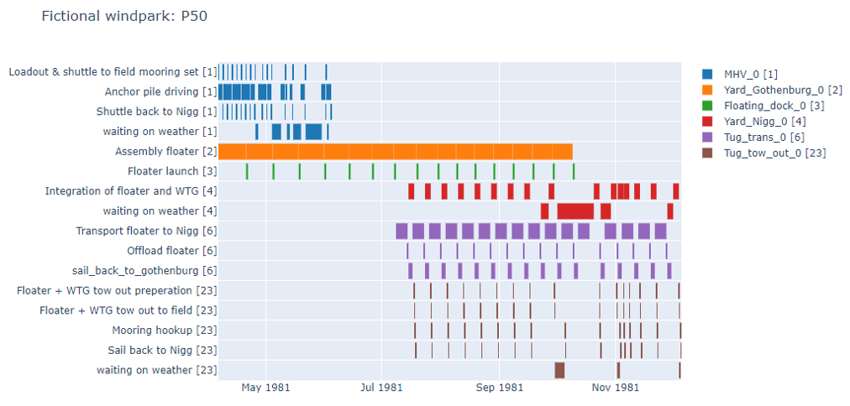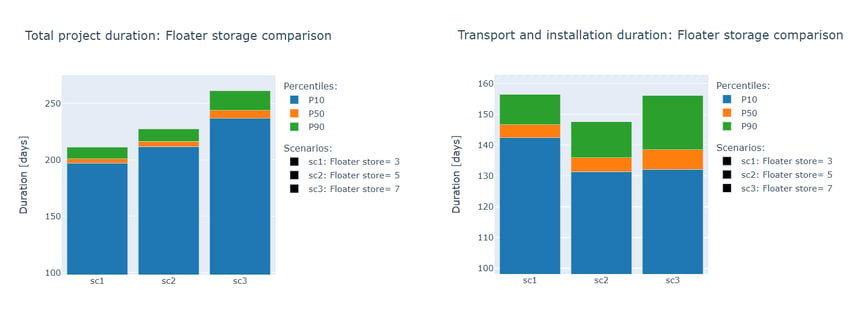Metis Example Project
Our software package, Metis, is capable of simulating various types of logistical problems. As an example, the installation of a fictional floating wind farm is considered. The wind farm consists of 16 wind turbines and will be placed on Scotland's East coast.
There are various moving parts in this simulation. Below, we give a quick textual overview, but be sure to also have a look at the short Gantt chart below. We find that this small chart can be very indicative when setting up these types of simulations.

- A monohull vessel starts at the Scottish port of Nigg, where it picks up a floater mooring set, including piles. Next, the vessel sails to the desired turbine location, where it drives the piles and pre-lays the mooring set. Now, the location is ready to receive a floater, and the monohull vessel will sail back to the port of Nigg to pick up the next mooring set.
- At the same time floaters are produced in the construction yard of Gothenburg. The floater production is an important process in this simulation, so an accurate representation is very important. The duration of this activity is represented by a Gamma distribution added to a linear learning curve. If you look closely at the spacing of the floater launches, you can see that the frequency goes up due to this learning curve. After launching the floaters, they are temporarily stored in a floating dock. The buffer capacity of the floaters in-port is a big driver of the duration of the installation vessel’s offshore campaign.
- Once the floating dock has been filled, a tug will start shuttling floaters from Gothenburg to Nigg. When the floaters arrive at Nigg, the tower, wind turbine generator and blades are assembled. Now, a separate tug tows the full windmill to a previously installed mooring set, where it is hooked up. After a successful hookup, the tug can return to Nigg to pick up the next windmill.
Weather can have a great impact on the risk and efficiency of a scenario. In this simulation, 40 years of historical weather data have been implemented at various locations. Activities within the simulation have been defined with weather limitations, and activities are postponed if these limits are exceeded, as you can see in the figure above.
To make the asset use in this scenario efficient, floater storage is required since the floater production cycles take longer than the other cycles. However, as mentioned in the simulation description, choosing the best-floating dock size to store floaters is not trivial. The transport cycle should not start until the floating dock is full because otherwise, we would have an over-dimensioned buffer zone. Having a very large storage, thus means that transport and installation cannot start early (given the floater production start date remains unchanged) and will thus lead to a long total project duration. Conversely, if the chosen storage is too small the tugs and port of Nigg would start waiting on the floater production, which would result in low asset efficiency. To find out which storage size would be most beneficial, simulations with three different buffer zone sizes are compared in the figures below.
Floater Storage Comparison

Looking at the left figure, we find that using a larger floater storage does indeed lead to a longer total project duration. However, if we look at the right figure, we find that using a small floater storage would indeed, in many cases, lead to a longer transport and installation duration. Lastly, we find that if seven floaters are stored, the transport and installation campaign's uncertainty increases. This is caused by the total project duration being longer and thus extending into the winter.
The next step for this analysis could be looking at alternative scenarios or including a breakdown. Would you like to see how Metis can de-risk your project? Send us a message at info@hes-heerema.com.
/People%20for%20job.jpg?width=600&name=People%20for%20job.jpg)
Are you ready to make waves?
Join the Heerema team!
